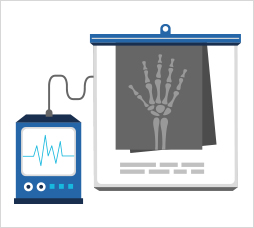Atomic Energy - The Third Fire
As humans started to use tools and fire, they became able to protect themselves from the nature that threatened their survival and began to be substantially dominant over nature.
Later, humans were given another gift, which is 'electricity', called the second fire. As electricity started to be used at full scale in industry and daily living, humans accomplished new changes, creating an industrial society, and achieving epoch-making progress.

In addition to electricity, humans were given, in the middle of 1900s, another gift, which is atomic energy, called the third fire.
However, unfortunately, at that time, atomic energy was developed as atomic bombs, during the Manhattan Project to terminate the Second World War, and causing tremendous disasters to humankind.
This led to the beginning of research works for the peaceful utilization of atomic energy. Since the US President Eisenhower declared 'Atoms for Peace' in 1953, atomic energy has been actively utilized in various fields to promote human welfare.

Value of Utilizing Radiation

The peaceful use of atomic energy can be roughly divided into two methods.
One is to use the huge energy or heat coming from nuclear fission and nuclear fusion, and the other is to use the unique characteristics of radiation coming from radioactive substances.
Radiation is capable of penetrating or ionizing an object and has the power to sterilize. In the process of penetrating an object, radiation may change the unique characteristics of the object.
Focusing on the characteristics of radiation, humans have actively conducted research seeking applications in various areas of engineering, environment, food, biotechnology, and space science, including sterilization of food and public health products, development of new natural and functional materials and products, development of new varieties of agricultural products and flowers, for medical purposes such as disease diagnosis and treatment, the removal of environmental pollution, and development of new materials for medical and industrial purposes.
Today, the technologies employing radiation have a significant impact on the value of many products and the development of industries, thus greatly contributing to improvements in the quality of human life, as well as human welfare. Radiation-based industries are rapidly growing worldwide in the present century.
According to the 2014 Radiation Utilization Status Survey (2016, Korean Association for Radiation Application), the international market size of each field utilizing radiation was growing, and was expected to reach 6.4 billion USD in radiopharmaceuticals (2019), 2.2 billion USD in diagnostic imaging (2020), 8 billion USD in radiotherapy (2019), and 49 billion USD in radiation instruments (2018).
In Korea, the total economic size of individual fields utilizing radiation as of 2014 was about 1.7 trillion KRW, which was a 1.7% increase in comparison with the previous year. The share of radiation utilization’s contribution to Korea's GDP was about 1.1%.
This shows that the economic size of radiation utilization in Korea is still small in comparison with advanced countries.
If this trend continues, Korea will have no choice but to be technologically subordinate to advanced countries in the radiation industry, which is internationally considered one of the industrial fields with the largest development potential as a future industry. This would result in a huge loss in view of the national economy.
Beginning in the 2000s, Korea has recognized the importance of the radiation industry and prepared and implemented various policies to foster the radiation industry as a new growth engine for Korea's future.
However, the government's support of R&D works, investment by industries, and the capabilities of domestic companies to meet future demands are still insufficient. Moreover, the system still has elements that prevent the activation of radiation industries. Therefore, the ratio of national R&D investment to non-power generation radiation utilization fields should be increased, support should be provided to such enterprises, and the relevant system should be presently improved.
The peaceful use of atomic energy can be roughly divided into two methods.
One is to use the huge energy or heat coming from nuclear fission and nuclear fusion, and the other is to use the unique characteristics of radiation coming from radioactive substances.
Radiation is capable of penetrating or ionizing an object and has the power to sterilize. In the process of penetrating an object, radiation may change the unique characteristics of the object.
Focusing on the characteristics of radiation, humans have actively conducted research seeking applications in various areas of engineering, environment, food, biotechnology, and space science, including sterilization of food and public health products, development of new natural and functional materials and products, development of new varieties of agricultural products and flowers, for medical purposes such as disease diagnosis and treatment, the removal of environmental pollution, and development of new materials for medical and industrial purposes.





